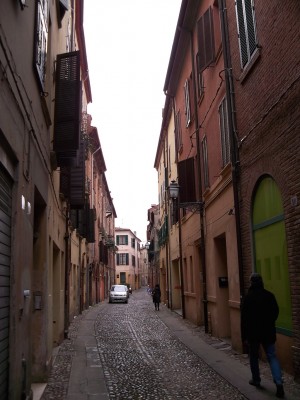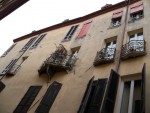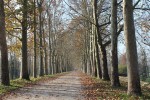Vittoria Street
Indeed, Via Gattamarcia is included in the ghetto area along with Via Mazzini and Via Vignatagliata.
2. Quotes
1. History
3. In literature
Via Vittoria is one of the streets in Ferrara’s old town that punctuates Giorgio Bassani's The Novel of Ferrara, portrayed often as a world unto itself. ‘”the Via Vittoria bunch...” This phrase usually referred to the members of four or five families who had the right to attend the small, separate Levantine synagogue, also known as the ‘Fanese’, situated on the third floor of an old Via Vittoria house, and so to the family of Da Fano of Via Scienze, to the Cohens of Via Giuoco del Pallone, to the Levis of Piazza Ariostea, to the Levi-Minzis of Viale Cavour, and to who knows which other isolated family group: all of them anyway people who were slightly odd, types always a shade ambiguous and evasive, whose religion, which in the Italian School had taken a more working-class and theatrical, almost Catholic turn, that was clearly reflected even in the character of the people themselves, largely extrovert and optimistic, typical of the Po valley, had in their case remained essentially a cult to be practised by the few, in semi-secret oratories at which it was opportune to arrive by night, in small numbers, slinking down the darkest and least known alleys of the Ghetto.’ (G. Bassani, The Garden of the Finzi-Continis’, in The Novel of Ferrara, translated by Jamie McKendrick, Penguin Classics, 2018, e-book location 4321)
Bibliography
- Luoghi ebraici in Emilia Romagna, Touring Club Italiano, Milano-Bologna 2006
- Melchiorri, Gerolamo, Bassi, Carlo, Nomenclatura ed etimologia delle piazze e strade di Ferrara. Ampliamenti all'opera di Gerolamo Melchiorri, 2G, Ferrara 2009
- Provasi, Matteo, Ferrara ebraica, 2G Editrice, Ferrara 2010
- Comune di Ferrara, Comunità Ebraica di Ferrara, Ferrara. Il ghetto Vai al testo digitalizzato
Fototeca
Related Itineraries
Related Themes
Related places
Compiling entity
- Istituto di Storia Contemporanea di Ferrara
- Assessorato alla Cultura e al Turismo, Comune di Ferrara
Author
- Federica Pezzoli
- Sharon Reichel
- Barbara Pizzo










